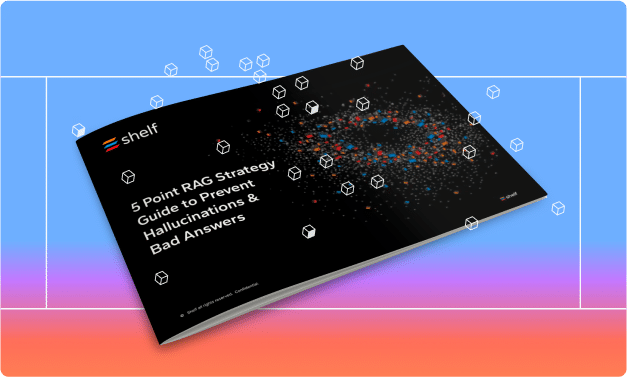Acronyms allow us to compact a wealth of information into a few letters. The goal of such a linguistic shortcut is obvious – quicker and more efficient communication, saving time and reducing complexity in both spoken and written language. But it comes at a price – due to their condensed nature and the variability in their meanings depending on the context, acronyms pose a unique challenge for AI.
Retrieval-Augmented Generation (RAG) systems, which blend search retrieval with generative AI, are especially challenged by the daunting task of deciphering these, often ambiguous, clusters of letters. The inherent brevity of acronyms, while beneficial for human efficiency, demands a high level of precision and adaptability from AI systems tasked with interpreting them accurately.
As AI models encounter acronyms across different domains and disciplines, they must consider all the potential interpretations, each tied to specific professional jargon, regional overtones, or industry-specific terminologies. This complex variability tests the limits of current AI technologies and shows us just how important sophisticated context-aware processing is to ensure reliable and coherent communication.
The Ambiguity and Context-Dependence of Acronyms
Even though there are 17,576 possible combinations of three letters, it’s estimated that about 70% of three-letter acronyms carry more than one meaning. What follows is that, in most cases, when a RAG system encounters an acronym, it faces a decision: should it assume the most statistically common meaning, or should it analyze the surrounding context to deduce the correct interpretation? Opting for the most common meaning might speed up processing and suit general cases, but can lead to inaccuracies in specialized or more complex discussions.
Risks of Misinterpretation – Nonsensical or Irrelevant Outputs
Disambiguation, the process of resolving the meanings of ambiguous terms in a given context, can make a difference between a helpful and unreliable RAG system. Some of the risks associated with misinterpretation and the generation of nonsensical or irrelevant outputs include:
Compounding Errors
Errors in initial retrieval due to ambiguous queries can lead to a chain reaction of errors in the generative process.
Scalability Issues
As the volume and variety of data increase, the challenge of accurately disambiguating terms scales accordingly. RAG models operating in domains with a high rate of ambiguous terms or jargon (such as legal, medical, or technical fields) are particularly at risk of generating inaccurate outputs if they cannot effectively disambiguate.
Impact on User Experience
Users expect coherent and contextually appropriate responses from AI systems. Outputs that are nonsensical, irrelevant, or factually incorrect can frustrate them, leading to reduced trust and reliance.
Difficulty in Traceability
When RAG systems generate incorrect or irrelevant information, tracing the error back to its source (whether in the retrieval or generation phase) can be a demanding task. This makes debugging and improving the system more difficult, as it’s not always clear whether the fault lies in the retrieval of information or its subsequent interpretation and use.
Risk of Misinformation
In accuracy-dependent scenarios, such as news dissemination, financial advice, or medical information, the risks of spreading misinformation due to poor disambiguation can cause significant trust, financial, or health-related consequences.
Human-written contexts
Even with human-written contexts, acronyms remain a challenge due to their condensed nature and the assumption of prior knowledge. People are not afraid of using acronyms without further clarification, expecting the reader to understand the meaning based on the context. For a RAG system, this presents a challenge in mimicking human-like understanding, requiring sophisticated linguistic models that can decipher subtle contextual hints and adjust their interpretations.

Handling Out-of-Vocabulary (OOV) Acronyms
Out-of-vocabulary (OOV) acronyms refer to abbreviations that are not present in a system’s trained dataset or pre-defined vocabulary – a blind spot, hindering the system’s ability to process and understand relevant content accurately.
When a RAG system encounters an OOV acronym, it confronts a barrier: the system lacks a referential basis to interpret the acronym, potentially leading to misinterpretation or outright failure in comprehension. This scenario disrupts the retrieval phase, where relevant data concerning the acronym fails to be accessed and extends to the generation phase, where the system might produce content that is either irrelevant or factually incorrect due to a flawed understanding.
Acronyms in Specialized Domains
Healthcare, biotechnology, legal, and finance – in specialized fields such as these, the continuous development of new concepts or technologies frequently gives rise to novel terminology and acronyms that condense complex ideas into a few letters. Some of these acronyms, while highly efficient for communication among experts, were likely not available during the initial training phases of most RAG systems.
Successfully Managing OOV Acronyms
To effectively manage rare or newly coined acronyms, RAG systems can employ several long-term strategies:
Continuous Learning and Updates
One of the most effective approaches is to design systems that can continuously learn and update their databases. By integrating new text and user interactions over time, the system gradually builds a more comprehensive database that includes even the newest and least common acronyms.
User Feedback Integration
Incorporating feedback mechanisms allows users to contribute to the accuracy of acronym interpretations. When a system misinterprets an acronym, users can provide the correct meaning, which the system then learns from.
LLMs
Pre-trained on vast corpora, LLMs like BERT, GPT-3, and T5 can be fine-tuned on domain-specific data to better understand acronyms in specialized contexts. Their attention mechanisms and ability to capture long-range dependencies help disambiguate acronym meaning based on broader context.
Named Entity Recognition (NER)
NER models can be trained to identify and classify acronyms and their expanded forms as named entities. This allows RAG systems to link acronyms with their full phrases and maintain consistency in usage and interpretation.
Word Sense Disambiguation (WSD)
WSD techniques like graph-based algorithms and supervised machine learning classifiers can be applied to determine the most likely meaning of an ambiguous acronym given the surrounding words and larger context. Knowledge bases like WordNet, domain ontologies, and acronym dictionaries can further aid this disambiguation process.
Contextualized Embeddings
Models like ELMo and BERT generate dynamic, context-sensitive embeddings for words/acronyms. Unlike static word embeddings, these account for an acronym’s specific usage in a sentence, helping capture its intended meaning more precisely for downstream retrieval and generation tasks.
Inferring Meanings from Limited Context
It’s only a matter of time until a RAG system encounters acronyms that are neither defined within the immediate text nor included in the system’s extensive training data. In such cases, the system must rely on the contextual clues available within the surrounding text.
To accurately hypothesize the plausible meanings of an acronym, a RAG system takes advantage of various linguistic cues:
Syntactic Structure
The placement and grammatical role of the acronym within a sentence help to narrow down its potential meanings. If an acronym is used as a noun in a technical paper, the system can infer potential industry-specific meanings based on common usage patterns.
Semantic Fields of Adjacent Words
Words surrounding the acronym provide context clues. For instance, words like “treatment” or “diagnosis” nearby might suggest that a medical interpretation of an acronym is appropriate.
Thematic Indicators
The overall theme of the text or section where the acronym appears guides the system in selecting domain-appropriate meanings. If the text discusses financial topics, acronyms are more likely to be interpreted with meanings related to economics or finance.
Additionally, RAG systems utilize co-occurrence patterns that have been learned during their training phase. These patterns indicate which words or phrases commonly appear in proximity to the acronym across various texts, providing hints about its possible meanings. By analyzing these patterns, the system can often deduce which interpretation of an acronym makes the most sense within a given context, even if that specific instance of the acronym is new to the system.
Inconsistencies in Acronym Usage
Acronyms can vary greatly in how they are written, capitalized, or expanded, which complicates the tasks of string matching and pattern recognition. Let’s take the acronym for “Search Engine Optimization” – it could be written as “SEO,” “S.E.O.,” or even “Seo” in less formal contexts. Each variation, while representing the same underlying concept, presents a unique pattern that a RAG system must recognize as equivalent. The challenge intensifies when acronyms are inconsistently capitalized across different documents or datasets, leading to further complications in recognizing them as identical entities.
Challenges in Pattern Recognition
Acronyms presented with varying punctuation, capitalization, or formatting divergences require pattern recognition algorithms that are flexible but not compromising on precision. Traditional string matching techniques might fail here, as they often rely on exact matches or simple variants. To address this, advanced techniques such as fuzzy matching and machine learning models are employed, which can tolerate minor variations in text while still recognizing the underlying patterns.
Embedding-based approaches, where terms are converted into high-dimensional vectors that capture semantic meanings, can be particularly effective. These methods allow the system to recognize that different stylistic representations of an acronym share a similar context and meaning, even if their literal strings differ. This vector space modeling enables the system to map different forms of an acronym to a single concept, facilitating more coherent information retrieval and generation.
However, training of such models requires large datasets that adequately represent the variability in acronym usage across different domains and contexts. Additionally, maintaining the balance between generalization and specificity—ensuring that models are neither too rigid in matching patterns nor too loose to the point of confusing distinct concepts—poses an ongoing challenge for developers of RAG systems.
Retrieval Challenges
Without their ability to retrieve, RAG systems would not only become “AG” systems, they would also be severely crippled in functionality. Acronyms, with their inherent complexity, pose substantial challenges to the retrieval capabilities of these systems, complicating the process of identifying and processing relevant data.
Differences in Acronym Usage
When acronyms are used inconsistently—appearing in different forms or representing different expansions—it can prevent the RAG system from recognizing that different documents are in fact discussing the same topic or concept, leading to fragmented or incomplete information retrieval. As a result, some documents that contain relevant information might not be retrieved because the acronym used there does not match the form or usage expected by the system based on the query context. This issue is further compounded in scenarios where acronyms are region-specific, industry-specific, or newly coined, making it unlikely that the system even has prior knowledge of all possible variations and meanings.
Acronyms not Matching Full Terms or Phrases
The retrieval accuracy of RAG systems can be substantially compromised when there is a discrepancy between the acronyms used in search queries and the full terms or phrases as they appear in source documents. This issue primarily stems from the variability in how information is documented and formatted. In many instances, documents consistently use either an acronym or its full expansion without clearly linking the two. This lack of direct correlation within the text can pose significant challenges for RAG systems tasked with identifying and extracting relevant information.
Similarly, when acronyms are used in a query but the corresponding documents use only the expanded forms—or vice versa—the RAG system may not successfully “realize” that the acronym and its full form are, in fact, connected. This disconnection can lead to the system overlooking fitting information because it fails to recognize that the acronym and the full term refer to the same concept.
Challenges of Finding Relevant Passages within Retrieved Documents
Once the initial retrieval phase is completed, the next task for RAG systems is to pinpoint the specific passages within these documents that are most relevant to the user’s query. This aspect of the process becomes particularly challenging in the presence of acronyms:
Unexpanded Acronyms
Often, documents contain acronyms that are not expanded or explained within the text. This can lead to difficulties in understanding the relevance of certain passages to the query.
Dependency on Context Clues
Without explicit explanations, RAG systems must rely heavily on broader context clues to determine the relevance of specific passages. This reliance increases the risk of selecting irrelevant or only partially relevant information.
Interpretation Challenges
The necessity to interpret complex contexts where acronyms have multiple meanings or are used in specialized ways adds another layer of complexity, making it hard to ensure the accuracy and relevance of the extracted information.
Error Propagation
Errors in understanding or identifying the correct meaning of acronyms can lead to a chain reaction where the subsequent information extraction and response generation are based on incorrect premises.

Techniques to Mitigate the Acronym Challenge
Acronym expansion and disambiguation in the RAG pipeline
Automated expansion clarifies the meaning of the acronym throughout the source material by converting all of the acronyms to their full forms throughout the processing stages. This ensures alignment between the user’s queries and the retrieved documents, minimizing discrepancies due to varied interpretations.
Contextual disambiguation is the key to this approach. It employs algorithms designed to interpret the contextual usage of an acronym, enabling the system to select the most accurate expansion relevant to the surrounding text.
Handling OOV Acronyms Through Subword Tokenization and Pointer/Copy Mechanisms
Subword tokenization involves breaking down words into smaller, manageable units (subwords), which can include parts of words or individual characters. This makes RAG systems able to handle words or acronyms that were not present in the training data by constructing them from known subwords.
Pointer or copy mechanisms complement subword tokenization by enabling the model to directly reference or ‘copy’ terms from the source text into the output. It allows the system to transfer exact terms from the retrieved documents into the generated response, maintaining accuracy and relevance. When a RAG system encounters an acronym that it cannot expand or disambiguate through traditional methods, the pointer mechanism can ensure that the acronym is still used correctly in context by copying it as is.
Leveraging Domain-Specific Resources for Improved Acronym Understanding
Glossaries, encyclopedias, and databases – all kinds of domain-specific resources can help RAG systems address queries focusing on particular industries or areas of expertise. By accessing these dedicated resources, the system can vastly improve its understanding of acronyms specific to different domains. Not to mention that such materials also allow the system to stay updated with the latest terminological developments in the field, even as new technologies emerge and terms evolve.
Pattern Matching and Normalization Techniques
Pattern matching involves the use of algorithms capable of recognizing different textual representations of the same acronym. This allows the system to identify and link disparate pieces of information that are conceptually related but presented differently due to textual variations.
Normalization goes a step further – Building on the initial step of pattern matching, it extends the process by standardizing the acronym variations into a singular, consistent format throughout the system. This standardization involves transforming all recognized variations of an acronym into a pre-defined uniform format. As a result, irrespective of the input variation, the output is standardized.

Strategic Integration for Accurate Acronym Management
For RAG systems to function optimally, effective acronym management is imperative. These systems require advanced language models and context-aware algorithms capable of not only identifying acronyms but also interpreting their meanings with precision based on the surrounding text. This involves complex processes such as parsing diverse linguistic structures, understanding specialized jargon across various domains, and integrating insights from extensive external data sources.
However, the challenge extends beyond the basic recognition and interpretation. It calls for a comprehensive alignment of the entire information retrieval and generation processes with the specific meanings of acronyms as intended in their contexts. This alignment is what’s crucial for maintaining the accuracy and relevance of the outputs provided by RAG systems. Without it, the risk of generating responses that are either misleading or disconnected from user intentions significantly increases, undermining the reliability and utility of these sophisticated AI tools.




